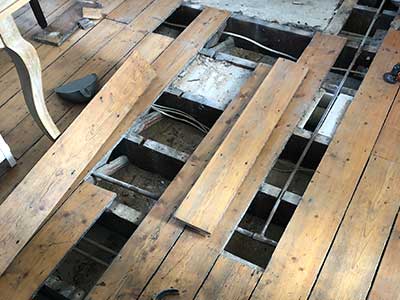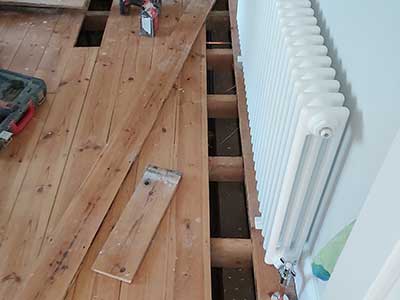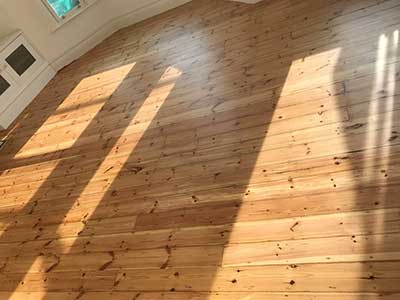Back to Wood Floor Fitting
Ultimate Guide to Suspended Timber Floors
 Suspended timber floors are a type of flooring system that involves raising the floorboards above the ground, creating a ventilated void between the floor and the soil. This design consists of timber joists that support the floorboards, allowing for air circulation beneath the flooring. Historically, suspended timber floors were introduced as a solution to the problems associated with traditional flooring methods, where wood floors were laid directly on the ground.
Suspended timber floors are a type of flooring system that involves raising the floorboards above the ground, creating a ventilated void between the floor and the soil. This design consists of timber joists that support the floorboards, allowing for air circulation beneath the flooring. Historically, suspended timber floors were introduced as a solution to the problems associated with traditional flooring methods, where wood floors were laid directly on the ground.
This direct contact led to significant issues with moisture, rot, and structural damage due to dampness. By elevating the floor, suspended timber systems help mitigate these risks, providing a more durable and long-lasting solution. Unlike conventional flooring, which often lacks ventilation, suspended timber floors promote airflow, reducing the likelihood of condensation and moisture buildup, thus enhancing the overall integrity of the building.
Advantages of Suspended Timber Floors
Suspended timber floors offer several significant advantages that contribute to their popularity in modern construction. Here are some key benefits:
-
Moisture Control:
- The elevated design prevents direct contact with soil, reducing the risk of moisture absorption.
- Allows for ventilation, which helps minimise dampness and rot, ensuring a healthier living environment.
-
Thermal Efficiency:
- Provides natural insulation, which helps maintain a comfortable indoor temperature.
- Effectively retains warmth during winter, leading to lower heating costs.
-
Flexibility:
- Offers easy access to plumbing and electrical systems, making maintenance straightforward.
- Allows for adjustments and repairs without major renovations, saving time and resources.
These advantages make suspended timber floors an excellent choice for homeowners looking for a durable, efficient, and flexible flooring solution.
Installation Process of Suspended Timber Floors
The installation process of suspended timber floors involves several crucial steps to ensure a solid and efficient structure. Preparation begins with a thorough site assessment and accurate measurements to determine the layout and requirements of the flooring. Selecting the right materials, including quality timber and suitable insulation, is essential for durability and performance.
During the construction steps, the first task is to lay the floor joists, which serve as the foundational framework for the flooring. Next, the floorboards are installed, creating the visible surface of the floor. To promote proper airflow and moisture control, it's important to add ventilation grills in strategic locations.
Finally, the finishing touches involve wood floor sanding and sealing the floor to achieve a smooth, attractive surface while protecting the wood from damage. Additionally, installing insulation enhances thermal efficiency, ensuring the space remains warm and energy-efficient. This comprehensive approach to installation guarantees a functional and long-lasting suspended timber floor.
Maintenance Tips for Suspended Timber Floors

Proper maintenance of suspended timber floors is essential for ensuring their longevity and performance. Here are some key maintenance tips to keep your floors in excellent condition:
Regular Inspections
- Check for signs of dampness or rot: Regularly inspect the area beneath the floorboards for any indications of moisture issues or wood decay.
- Ensure ventilation openings are unobstructed: Make sure that all ventilation grills are clear of debris and not blocked, allowing for proper airflow and moisture control.
Cleaning and Care
- Recommended cleaning products and methods: Use gentle cleaning products that are specifically designed for wood floors. A damp mop and a pH-balanced cleaner can effectively remove dirt without damaging the surface.
- Importance of avoiding excess moisture during cleaning: Be cautious not to saturate the floor with water, as excess moisture can lead to swelling or warping of the timber.
Repairs
- How to replace damaged floorboards: If you notice any damaged or rotten floorboards, carefully remove them and replace them with new timber. Ensure the new boards match the existing ones for a seamless look.
- When to consult a professional for structural issues: If you encounter significant structural problems or extensive rot, it’s crucial to consult a professional to assess and address the issues before they worsen.
By following these maintenance tips, you can help extend the life of your suspended timber floors and maintain their beauty and functionality for years to come.
Common Issues and Solutions
Suspended timber floors, while beneficial, can encounter several common issues. Here are some of the most prevalent problems and their corresponding solutions:
Dampness and Moisture Problems
- Causes: Poor ventilation, rising dampness, or inadequate insulation can lead to moisture accumulation under the floorboards.
- Prevention Strategies:
- Ensure proper ventilation: Install ventilation grills to promote airflow and reduce humidity.
- Use a vapour barrier: Lay a vapour barrier between the soil and the floor to prevent moisture ingress.
- Regular inspections: Monitor for signs of dampness and address any leaks or water sources immediately.
Pest Infestation
- Identifying Signs of Infestation: Look for droppings, gnaw marks, or damaged wood. Insect activity, such as wood-boring beetles, can often be detected by small holes in the timber.
- Prevention and Control Measures:
- Regular inspections: Conduct routine checks for signs of pests, especially in damp areas.
- Seal gaps and cracks: Close off entry points around pipes and vents to prevent pests from accessing the space.
- Professional pest control: If an infestation is detected, consult a pest control professional to implement effective treatment options.
Uneven Floors
- Causes of Unevenness: Settlement of the building, rotting timbers, or improper installation can result in an uneven floor surface.
- How to Address Them:
- Assess the underlying structure: Check the joists and beams for damage or decay. If floor repairs are needed, address them promptly.
- Use shims: If only minor adjustments are needed, shims can be placed under the floorboards to level them out.
- Consult a professional: For significant unevenness, it’s advisable to seek the expertise of a flooring specialist who can evaluate and correct the issue effectively.

In summary, suspended timber floors offer a range of benefits that make them a compelling choice for both residential and commercial spaces. Their elevated design provides excellent moisture control, helping to prevent dampness and rot while promoting ventilation. Additionally, the natural insulation properties of suspended timber contribute to thermal efficiency, ensuring warmth during the colder months.
The flexibility of suspended timber floors also allows for easy access to plumbing and electrical systems, making maintenance and adjustments straightforward. With proper installation and regular maintenance, these floors can provide lasting durability and aesthetic appeal.
Given these advantages, we encourage you to consider suspended timber floors for your next flooring project. Whether you’re renovating your home or designing a commercial space, this flooring option combines practicality with timeless elegance, making it a worthwhile investment for any property.